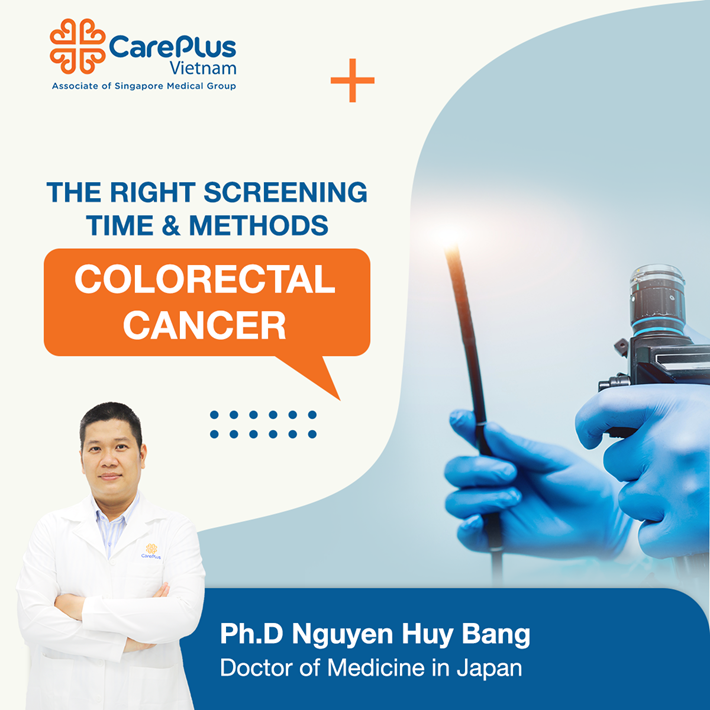Colorectal Cancer - The right screening time and methods
Colon cancer is a common disease, accounting for a high rate in the world and in Vietnam. In our country, there is still no national cancer screening program or specific guide for people on early colorectal cancer screening. Screening means looking for abnormalities, precancerous lesions or polyps in the colon when the patient does not have any symptoms. Detecting colorectal cancer before symptoms appear significantly improves the chances of survival and reduces the psychological, economic, and social burden.

6/20/2023 1:41:12 PM
Subjects with intermediate or high risk factors for developing colorectal cancer are recommended to be screened according to the US colorectal cancer screening guidelines.
Subjects with intermediate or high risk factors for developing colorectal cancer are recommended to be screened according to the US colorectal cancer screening guidelines.
People at average risk are those 40 years of age and older with no symptoms (symptoms associated with colorectal cancer such as bloating, gas, abdominal cramps, change in bowel habits, flat stools, etc.) , bloody stools, etc.) and no family history of colorectal cancer (ie, no affected next of kin such as siblings, parents, or children).
Subjects with high risk factors for colorectal cancer include:
Family history of hereditary colorectal cancer syndrome. About 5% of colon cancers in the US are caused by hereditary colon cancer syndromes. Over 85% of patients have inherited one of the genetic syndromes with a very high risk of colon cancer, eg.
- Familial adenomatous polyposis (FAP)
- Hereditary nonpolyposis colorectal cancer (HNPCC) or Lynch syndrome
- Polyposis syndrome is an inherited colon cancer syndrome.
Personal or family history of colorectal cancer or advanced adenomatous polyposis: meaning 1 first-degree relative (parent, sibling, or child) had these diseases before age 60, or ≥ 2 first-degree relatives with these diseases at any age.
Personal history of chronic inflammatory bowel disease (IBD) (eg, ulcerative colitis or Crohn's disease).
One-step screening
One-step screening means only one method is required. Colonoscopy is the most effective and thorough 1-step screening method.
Colonoscopy
Colonoscopy is the most commonly performed gastrointestinal procedure worldwide, the most effective and thorough 1-step screening method, not only allowing the detection of precancerous and cancerous lesions. early stage, but also detect and remove polyps, thereby ensuring long-term morbidity and mortality from colorectal cancer.
Among screening tools, colonoscopy has the highest sensitivity in detecting colorectal cancer and colon polyps, allowing removal of lesions anywhere in the colon at once. Screening with the ability to detect and remove adenomatous polyps before turning into malignancy. High quality endoscopy is required to ensure screening value.
TWO-STEP SCREENING METHODS
Two-step screening is necessary for additional methods if one-step screening results are positive.
Fecal occult blood detection by immunohistochemistry: if the test result is positive, endoscopy should be performed promptly to find the cause.
- Stool DNA test: Is a new, non-invasive method to find colorectal cancer for people who want to be screened but do not want to have a colonoscopy… Can help detect disease early before symptoms appear. proof. Once cancerous or precancerous is detected, a colonoscopy should be performed to confirm cancer and possibly remove polyps. However, this measure is not popular in Vietnam
- Sigmoidoscopy: the screening rate by flexible sigmoidoscopy has been greatly reduced because it does not examine the entire colon but only a segment of about 40cm, this procedure does not help screen for lesions in the segment. high in the colon. The colonoscopy process is also not anesthetized, so it is uncomfortable and when an adenoma is detected, a colonoscopy is also required.
- Computed tomography colonoscopy (CTC): also known as “colonoscopy”. CTC was performed once a year. CTC is more sensitive than any test other than colonoscopy for detecting adenomatous polyps. If the CTC is suggestive of polyps or rectal cancer, the patient should have a timely colonoscopy for evaluation. For older patients with underlying comorbidities (eg, comorbidity, carrier status, or history of stroke, etc.), CTCs may be preferred over colonoscopy, because its risks of colonoscopy increase with age. However, patients with detectable cervical abnormalities should undergo endoscopy. Therefore, patients choosing CTCs should also be able to tolerate colonoscopy.